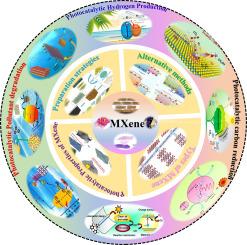基于 MXene 的框架在光催化制氢、二氧化碳减排和污染物降解方面的进展:当前挑战与未来展望
IF 20.3
1区 化学
Q1 CHEMISTRY, INORGANIC & NUCLEAR
引用次数: 0
摘要
由过渡金属碳化物和氮化物组成的二维-MXene 框架(2D-MXene)被认为是下一代先进材料,由于其高度有序的框架、可控的结构、较大的比表面积以及丰富的表面官能团等令人难以置信的特性而备受青睐。但由于二维氧化铝的表面活性位点相对稀少、稳定性较低以及光催化反应的结构构造等原因,其在大多数研究领域的实际应用仍处于提升阶段。因此,得益于各种 MXene 制备策略的进步,现在研究人员很容易理解 MXene 合成的每一步背后的弱点,其精确的形态和可调的特性可用于多种应用。此外,文献中还没有充分总结改良结构的 MXene 在光催化氢进化(PHE)、光催化碳还原(PCR)和光催化污染物降解(PPD)中的潜在应用、主要缺点和潜在解决方案的最新信息。有鉴于此,这篇综述文章对其背景、结构信息、发展简史以及可调特性合成过程中的重要里程碑进行了研究,以便更好地了解其 PHE、PCR 和 PPD 特性。其中,详细讨论了 MXene 作为光催化剂的作用以及不同类型的 MXene(0D、1D、2D、3D)。最后,本综述还讨论了开发高性能 MXene 以提高光催化活性的当前挑战和未来建议。因此,我们的综述将以一种可持续的方式开启一种新的认识,以促进基于 MXene 的光催化剂的发现和应用,从而改善光催化应用。本文章由计算机程序翻译,如有差异,请以英文原文为准。


Advancements in MXene-based frameworks towards photocatalytic hydrogen production, carbon dioxide reduction and pollutant degradation: Current challenges and future prospects
The 2D-MXene frameworks (2D-MXene) comprising transition metal carbide, nitride, is regarded next generation advanced material, that have procured significant courtesy owing to their incredible characteristic of highly ordered framework, controllable structure, large surface area, along with ample surface functional groups. As, practical application of MXene in most research fields is still at up grading phase owing to their relatively rare surface-active site, low stability and structural configuration for photocatalytic reaction.The substantial research has been devoted to maximize their advantages and mitigate the shortcomings of 2D-MXene for photocatalysis. Thus, thanks to the progress of various kinds of MXene preparation strategies, now researcher could easily understand the weakness behind every step of MXene synthesis with accurate morphology and tunable characteristics for numerous applications. Besides, MXene with improved structure and up-to-date information regarding potential application in photocatalytic hydrogen evolution (PHE), photocatalytic carbon reduction (PCR) and photocatalytic pollutant degradation (PPD) along with key drawbacks and potential solutions is not sufficiently summarized in literature yet. By keeping in view these facts, this review article investigated the background, structural information, brief timeline of its progress, and notabl milestone in its synthesis with tunable properties to get better understanding about their PHE, PCR and PPD properties. In which, the role of MXene as a photocatalyst, along with different types of MXene (0D, 1D, 2D, 3D) is discussed in detail. Finally, the current challenges and their future recommendation on developing high performance MXene to improve photocatalytic activity, is discussed in this review. Hence, our review will open a new understanding in a sustaianble way to facilitate the discovery and application of MXene based photocatalyst to improve photocatalyticapplication.
求助全文
通过发布文献求助,成功后即可免费获取论文全文。
去求助
来源期刊

Coordination Chemistry Reviews
化学-无机化学与核化学
CiteScore
34.30
自引率
5.30%
发文量
457
审稿时长
54 days
期刊介绍:
Coordination Chemistry Reviews offers rapid publication of review articles on current and significant topics in coordination chemistry, encompassing organometallic, supramolecular, theoretical, and bioinorganic chemistry. It also covers catalysis, materials chemistry, and metal-organic frameworks from a coordination chemistry perspective. Reviews summarize recent developments or discuss specific techniques, welcoming contributions from both established and emerging researchers.
The journal releases special issues on timely subjects, including those featuring contributions from specific regions or conferences. Occasional full-length book articles are also featured. Additionally, special volumes cover annual reviews of main group chemistry, transition metal group chemistry, and organometallic chemistry. These comprehensive reviews are vital resources for those engaged in coordination chemistry, further establishing Coordination Chemistry Reviews as a hub for insightful surveys in inorganic and physical inorganic chemistry.
 求助内容:
求助内容: 应助结果提醒方式:
应助结果提醒方式:


